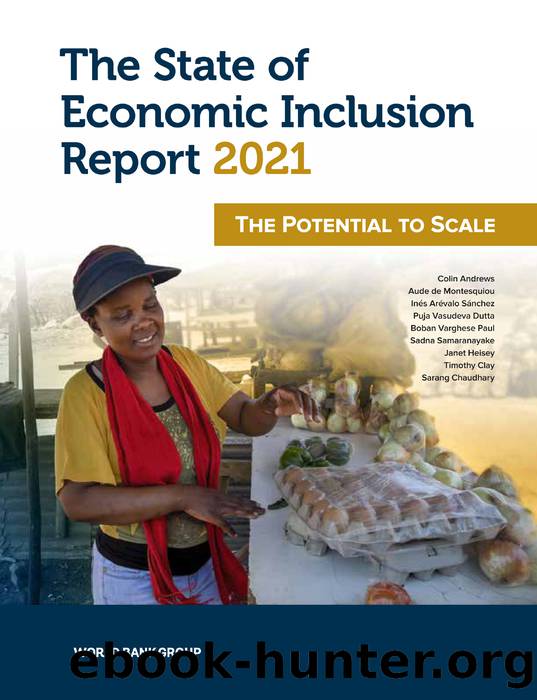The State of Economic Inclusion Report 2021 by unknow

Author:unknow
Language: eng
Format: epub
Source: Bertrand et al. 2017.
Note: PWP = public works program. All outcomes plotted on the vertical axis are monetary values in the shared Central African currency (CFAF). Short-term impact is estimated 12â15 months after program completion (with program duration approximately 7 months). PEJEDEC = Projet dâUrgence de Création dâEmploi Jeunes et de Développement des Compétences.
* significance at 10 percent, ** 5 percent, and *** 1 percent. n.s. = not significant.
Some complementary programs also display these positive synergies, with the cumulative impact greater than that of the individual programs. For instance, in Brazil the overlapping implementation of Bolsa FamÃlia (a conditional cash transfer) and Pronaf (a subsidized agricultural credit) had a greater aggregate impact on land productivity and income than the individual programs (Garcia, Helfand, and Souza 2016). In Malawi, the joint impact of an unconditional cash transfer and farm input subsidy was about 22 percent larger than that of the sum of the impacts of the stand-alone programs on the value of production (Daidone et al. 2017). As previously noted, however, many complementary programs do not have any additive or multiplicative impact of the combined programs.
It is possible that in some contexts further bundling may be necessary to address the multiple constraints faced by the target populations. In Peru (prior to Haku Wiñay), complementary programsâa conditional cash transfer (Juntos) and technical training (Sierra Sur)âinfluenced the adoption of new technologies and increased assets. However, these changes did not translate into higher income in the absence of financial or other support (Aldana, Vásquez, and Yancari 2016). Similarly, in Côte dâIvoire, the Projet dâInsertion Socio-Economique program (PRISE) found very little difference across different variants (combining training with semicredit, cash grant, or establishment of village savings and credit association). Possibly, additional interventions, such as a regular cash transfer, may have been necessary in the fragile, postconflict setting (Premand and Marguerie 2020).
In summary, the emerging evidence suggests that a bundled set of interventions has greater impact than its constituent stand-alone interventions. However, knowledge of this key aspect of economic inclusion programming is still limited. Further research is needed to conclusively establish this finding, particularly if this holds at scale, for different population groups, and across a range of contexts. It is also important to better understand the marginal impact (and costs, see chapter 6) of each intervention, relative to the overall impact of the program, in order to identify cost-effective bundles for different population groups and contexts.25
Heterogeneity of Impact: Not Everyone Benefits to the Same Extent
Program impact often varies across participants, with greater impact on incomes and assets for the least poor among the target population. For instance, in the medium term, the impact of the classic graduation pilots on the asset index among people at the 90th percentile was more than 14 times greater than among those at the 10th percentile (Banerjee et al. 2015). In Afghanistan, a similar program (TUP) also found significantly higher impact on livestock holdings for the top relative to the bottom quintile (Bedoya et al. 2019). In Bangladeshâs TUP,
Download
This site does not store any files on its server. We only index and link to content provided by other sites. Please contact the content providers to delete copyright contents if any and email us, we'll remove relevant links or contents immediately.
| Abuse | Death & Dying |
| Disaster Preparedness | Drugs |
| Dysfunctional Relationships | Homelessness & Poverty |
| Illness | Prejudice & Racism |
| Runaways | Violence |
Call me by your name by Andre Aciman(4613)
Rowling, J.K - Harry Potter 02 - Harry Potter and the Chamber of Secrets by Rowling J K(3260)
Paardenranch heartland - vol vertrouwen by Lauren Brooke(3119)
Harry Potter and the Chamber of Secrets (Book 2) by J.K. Rowling(2780)
The Kiss of Deception by Mary E. Pearson(2753)
Harry Potter and the Goblet of Fire (Book 4) by J.K. Rowling(2723)
Day by Elie Wiesel(2717)
A Thousand Splendid Suns by Khaled Hosseini(2615)
Holes by Louis Sachar(2603)
How to Make a Wish by Ashley Herring Blake(2551)
Just Listen by Sarah Dessen(2523)
I've Got Your Number by Sophie Kinsella(2464)
Bossypants by Tina Fey(2463)
Holding Up the Universe by Jennifer Niven(2462)
Talking as Fast as I Can by Lauren Graham(2380)
Confessions of a Shopaholic by Sophie Kinsella(2278)
Call Me by Your Name: A Novel by André Aciman(2181)
The Body Keeps the Score by Bessel van der Kolk MD(2140)
No Time to Say Goodbye(2057)
